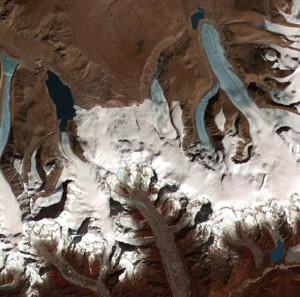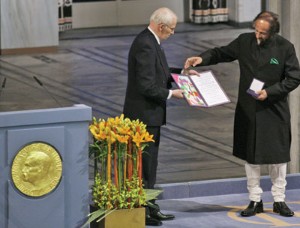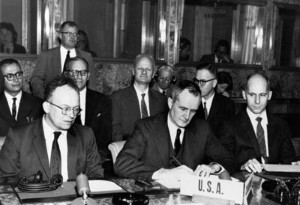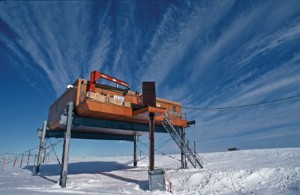The unique set of challenges that face humankind today mean that it is more essential than ever that Earth scientists apply their understanding of the planet to benefit society and that society invite them to do so.
In a single sentence of a speech to the Royal Society, in London, in 1988, Margaret Thatcher succinctly connected science to the creation of social wealth when she said: “the value of Faraday's work today must be higher than the capitalization of all the shares on the stock exchange.” Add a few other examples of the work of scientists that has transformed society, such as the Green Revolution in world agriculture, the transistor revolution that opened closed societies to change and the biomedical revolution set off by molecular biology, and the benefits of science to society take on real meaning. The Earth sciences have a unique role in this regard, which was underscored by the twentieth-century US historian Will Durant when he is said to have cautioned: “Civilization exists by geological consent, subject to change without notice.” Today, Durant might add a few new vulnerabilities faced by civilization, which I comment on later in this article.
Engagement by scientists in societal matters is not without its problems. An essential element of a democratic society is the accountability of elected officials, who make the final decisions but are answerable to the people. When a serious social problem is addressed, however — one that involves technical matters — scientists are frequently called on for advice. More often than not, the available data are incomplete, the issue is politically charged and the scientists must hold to the integrity of the scientific process in the face of their own personal biases and possible conflicts of interest. In such circumstances, scientists can help decision-makers by describing a range of possible outcomes — assuming there is enough information to do so. However, there are crisis situations where default judgments are needed: that is, where decisions must be made and there is not enough time for more years of research. In this case, I for one would prefer to solicit the views of the most qualified experts in the field in full knowledge of the possible difficulties noted above. Climate change may be such an issue. Crispin Tickell, a former British ambassador to the United Nations, argued the issue this way1: “Scientists should be much braver ... I think this ethics argument — should they speak or shouldn't they — is a lot of nonsense. Scientists cannot promise certainty any more than economists can when they call for changes in taxes or interest rates. Uncertainty is part of the human condition. Caution, in any case, may in reality be recklessness. We must always look at the cost of doing nothing.”
In negotiating the conditions for my position as science adviser to US president Jimmy Carter in early 1977, I learned that he selected me because I was an Earth scientist. To me this signalled his estimate of the important issues he would have to confront in his term of office. I asked the president for the authority to convene panels of experts to sort through technical issues that might relate to a presidential decision, and this proved to be an important mechanism for providing the counsel of the ranking specialists in a field. On occasion, the president, who was technically competent, chose not to follow our advice, but he respected the process and, where appropriate, he explained the political rationale for his decision.

There are numerous examples of both the contributions that Earth scientists have made to society, and of the effects that society has had on the disciplines within Earth science, and I discuss just a few of them here.
Natural resources
Just about everything we use — our metals, many of our chemicals, our building materials, silicon for our transistors, our energy resources — comes from the ground. These resources are discovered by geologists who tell us how they were formed, how to find them, and that they will not last forever. Unfortunately, mining can be a dirty business that ravages the environment. Environmental scientists now counsel conservation, recycling and substitution as alternatives to the mining of diminishing resources.
Fresh water, a life-sustaining resource, is faced with growing chemical pollution together with increasing demand. A new threat reported by glaciologists is the retreat of glaciers with the beginnings of global warming. They alert us that this will reduce Earth's water-storage capacity and seasonal freshwater run-off in many regions, threatening water supplies for drinking and irrigation.
Living on a violent planet
The same forces that have made our planet so uniquely conducive to life by providing us with continents, oceans and a beneficent atmosphere have also made it a violent planet subject to earthquakes, tsunamis, volcanic eruptions, landslides and floods. Earth scientists share with public authorities the responsibility for showing humankind how to live with these natural hardships and minimize the loss of life and property. In all these cases, they do this by public education, recommending intelligent land use together with regulations that require disaster-resistant design of buildings and other structures. In the case of natural disasters, science can provide early warning with increasing reliability. Earthquake prediction still remains an elusive goal, but real-time seismology is offering hope of improved mitigation (see page 271).
Climate change
Worrisome as these natural threats are, humankind itself has now become a new troubling force that competes with geology in its power to change our planet. Our ability to alter the chemistry of the atmosphere and thereby change global climate now compares with the natural swings in climate found in the geological record extending back in time over millions of years (see page 279). This is an awesome responsibility because of the profound consequences for humankind and all other living species. In 1896, Swedish scientist Svante Arrhenius calculated that doubling the carbon dioxide (CO2) content in the atmosphere would raise Earth's temperature by 5–6 °C. He proposed that the release of CO2 by the combustion of coal would produce global warming. At long last, more than 100 years after Arrhenius's warning, Earth scientists have finally won over most of the world's political leaders to the view that the increased emission of greenhouse gases caused by human activity is responsible for measurable levels of global temperature rise since the mid-twentieth century. The scientists were able to present evidence of troublesome changes in physical and biological systems that could be observed. They could cite detailed observations of receding glaciers, reduced sea-ice cover on the Arctic Ocean, more frequent extreme weather events, early-blooming trees and acidifying oceans. This cause-and-effect linkage was the stunning message in a report by a scientific panel appointed by the United Nations. Hundreds of climate experts from 120 governments contributed to this statement, issued in 2007 by the UN Intergovernmental Panel on Climate Change (IPCC)2, and have been rewarded for their efforts by a share in the 2007 Nobel Peace Prize — arguably the highest recognition that scientists can receive for a contribution to society.
In addition, many leading climate scientists are taking what is for them an unusual but necessary action. They are 'going public': that is, expressing in public forums their anxiety about the possible disastrous consequences by the end of this century of unchecked global warming. They are rousing the general public, making this an economic and ethical issue for many business leaders and a political issue for the governments of many countries. Climate experts are now being joined by the many political leaders they have briefed in arguing that even in the absence of absolute certitude (which does not exist for any scientific theory), reduction in greenhouse-gas emissions is mandated because of the non-trivial possibility that global warming could trigger disastrous social and environmental changes. Climate change is an example of a problem faced by scientist-advisers in counselling governments when the issue is politically charged and the early data are incomplete. These scientists persisted, however; the flow of observations and computations buttressed their case, and they are now forcing economic and political action.

The ozone hole
Perhaps the most successful example of advice by Earth scientists informing government policy is that of the Montreal Protocol, an international agreement that became effective in 1989 to control the production of industrial chemicals that threatened to destroy the ozone layer in the stratosphere. The rapidity of negotiation and implementation following the publication of the scientific data was remarkable. In 1995, atmospheric chemists Paul Crutzen, Sherwood Rowland and Mario Molina were awarded the Nobel Prize in Chemistry for their work more than two decades earlier on the formation and decomposition of ozone. Molina and Rowland3 had proposed that a class of normally harmless, commonly used industrial compounds called chlorofluorocarbons, or CFCs, could drift up to the stratosphere. There, photodissociation of the CFCs in a catalytic reaction could produce atomic chlorine that would destroy ozone. Earth's ozone layer, the protective shield that filters cell-damaging solar ultraviolet radiation from reaching the biosphere, could be thinned. In the 1980s, when Earth scientists and others were trying to gain public attention for a possible environmental disaster, a highly placed US government official offered advice that ranks with Marie Antoinette's counsel to starving Parisians: “Let them eat cake.” He proposed that as a cheap and effective solution people should wear hats and sunglasses and use sunscreen. Fortunately, ozone depletion over Antarctica was discovered by the British Antarctic Survey in 1985. In the following year, a team of international scientists led by Susan Solomon of the National Oceanic and Atmospheric Administration made in situ measurements in the 'ozone hole'. The chemistry of the ozone hole was confirmed. With this evidence, wiser political voices prevailed, and a treaty was rapidly negotiated. By 2007, some 191 countries had ratified the Montreal Protocol, which now envisages the complete phasing out of ozone-depleting substances.
The nuclear test-ban treaty
Nuclear weapons cannot be developed with confidence that they work without testing. An enforceable ban on testing would thus be a powerful deterrent both to the proliferation of states with nuclear arsenals and to concealed advances in weapons development by nuclear-capable states. We would not be as close as we are today to such a ban without either the work of Earth scientists or the influence of society on the field of seismology. For some 40 years, the United States, Russia and other countries with nuclear weapons have been trying to reach agreement on methods to verify compliance with a test-ban treaty by developing a reliable tool to detect clandestine underground testing of nuclear weapons. Seismic detection of explosions was the obvious technology, but in the early years of negotiations over a treaty, the field of seismology was insufficiently developed to do the complete job of detecting a nuclear explosion, locating it and stating with confidence that the event was an explosion and not an earthquake. That was the driver that transformed the tiny academic research field of seismology into a military–industrial–academic complex that would expose seismologists to the seductions of huge funding increases, co-option by government officials with political agendas, distortion of their research priorities and biased selection of data in publications and testimony.

The first negotiations for a test-ban treaty consisted of several meetings of US, British and Soviet scientists in Geneva, beginning in 1958 (in what follows, I draw on the excellent descriptions of the early history of the nuclear test-ban negotiations in refs 4 and 5). The government of the Soviet Union was leery of foreign inspectors roaming freely in their country in search of evidence for clandestine tests, and Soviet seismologists presented seismological data that supported this political policy, claiming that their seismic networks could easily detect even small detonations of chemical explosives at distances of hundreds of kilometres. The US government thought the Soviets capable of and willing to evade a treaty, and US government scientists presented apparently contradictory evidence of how difficult it was to observe seismic waves generated by the much larger underground nuclear explosions in the United States. They maintained that they would need many seismic stations in the Soviet Union, as well as inspections, to monitor clandestine underground nuclear explosions. Each side suspected the motives of the other's scientists in presenting seemingly slanted evidence in support of their government's political position, but subsequent scientific work revealed that differing regional geology could account for the contradictions. It turned out that the ancient, colder (having a lower geothermal gradient) crustal and mantle rocks of the Eurasian continental shield are more effective at generating and propagating seismic waves from an explosion than are the rocks under the Nevada test site, which sits in a geologically younger region where conditions tend to muffle seismic waves.

To avoid disruption of the negotiations because of the conflicting technical positions of the delegations, the administration of President Eisenhower launched a research programme in seismology called Vela Uniform. An advisory panel was appointed by the president's science adviser James Killian of the Massachusetts Institute of Technology to prepare a research plan. The panel, chaired by science administrator Lloyd Berkner, consisted of 14 members, of whom 9 were distinguished university professors, including 6 of the nation's leading academic Earth scientists. The highly respected Advanced Research Projects Agency (ARPA) of the Department of Defense was designated to manage Vela Uniform, and the Berkner Report set its research agenda. Kai-Henrik Barth reported4: “Vela Uniform supported almost every US seismologist and even a number of foreign scientists during the 1960s. From 1959 to 1961, funding for seismology increased by a factor of 30 and remained at this level for the better part of the 1960s.” Of great importance to the development of seismology is the fact that the government managers of these research funds knew how to find and support the best scientists and provided them wide latitude in the selection of their own research topics, knowing that this was in the best long-term interest of the government.

As far as seismology is concerned, fears about militarization of the field during the cold war, and distortion of the research agenda into narrow sectors of special interest to government patrons, never materialized. On the contrary, the US government's generous support of academic Earth scientists with few limitations over the decades not only led to the development of many advanced methods for differentiating between nuclear explosions and earthquakes but also enabled seismologists to make extraordinary contributions to the study of plate tectonics and to the unravelling of the dynamics of Earth's internal heat engine.
The seismological methods that were developed also had a crucial role in facilitating the adoption of the Comprehensive Nuclear Test-Ban Treaty by the United Nations in 1996, by giving states confidence that compliance with the treaty could be verified. A global international monitoring system of 170 seismic stations, which should be capable of detecting and identifying nuclear explosions as small as 1–2 kilotonnes (ref. 6), is now being installed as part of the treaty. This should be sufficient to inhibit any rogue nation from secretly developing a nuclear weapon. I am sure that it will also lead to new discoveries about Earth's interior and provide useful data for early warning of earthquakes, tsunamis and volcanic eruptions in remote regions.
Earth scientists should be proud of the contributions to society they are making in the course of applying and advancing their science. The wider application of old knowledge still serves many purposes, including lessening the destruction of natural disasters. The latest challenge is to apply the new understanding of our planet that has been uncovered by research to halt and reverse the environmental damage inflicted by humankind.
References
Pearce, F. The green diplomat. New Sci. no. 1813 38 (1992).
Solomon, S. et al. (eds) Climate Change 2007: The Physical Science Basis. Contribution of Working Group I to the Fourth Assessment Report of the Intergovernmental Panel on Climate Change (Cambridge Univ. Press, Cambridge, UK, 2007).
Molina, M. J. & Rowland, F. S. Stratospheric sink for chlorofluoromethanes: chlorine atom catalysed destruction of ozone. Nature 249, 810–812 (1974).
Barth, K. The politics of seismology: nuclear testing, arms control, and the transformation of a discipline. Soc. Stud. Sci. 33, 743–781 (2003).
Richards, P. G. & Zavales, J. in Monitoring a Comprehensive Test Ban Treaty (eds Husebye, E. S. & Dainty, A. M.) 53–81 (Kluwer Academic, Dordrecht, 1996); revised <http://www.ldeo.columbia.edu/~richards/earlyCTBThistory.html>.
Committee on Technical Issues Related to Ratification of the Comprehensive Nuclear Test Ban Treaty, and Committee on International Security and Arms Control, National Academy of Sciences. Technical Issues Related to the Comprehensive Nuclear Test Ban Treaty (National Academy of Sciences, Washington DC, 2002).
Author information
Authors and Affiliations
Additional information
Author Information Reprints and permissions information is available at http://npg.nature.com/reprints.
Correspondence should be addressed to the author (fpress@theadvisorygroup.com).
Rights and permissions
About this article
Cite this article
Press, F. Earth science and society. Nature 451, 301–303 (2008). https://doi.org/10.1038/nature06595
Published:
Issue Date:
DOI: https://doi.org/10.1038/nature06595
This article is cited by
-
Spatio-temporal Variations of Temperature and Precipitation During 1951–2019 in Arid and Semiarid Region, China
Chinese Geographical Science (2022)
